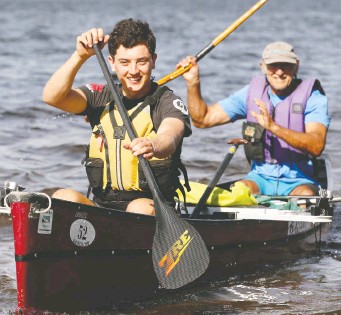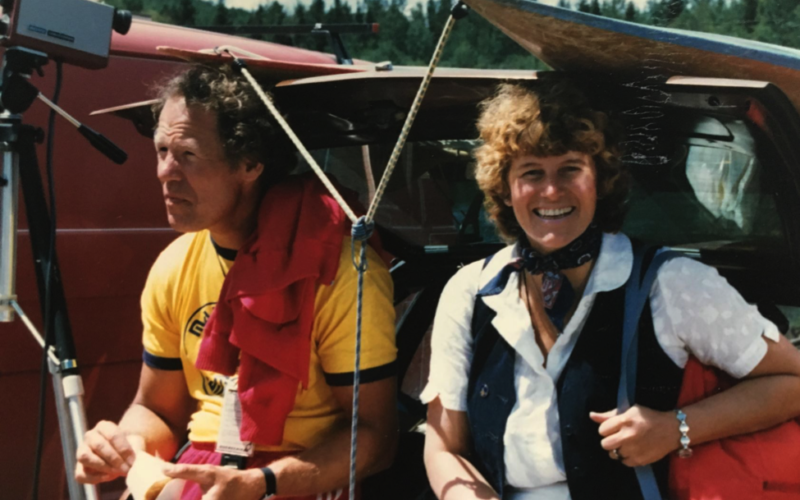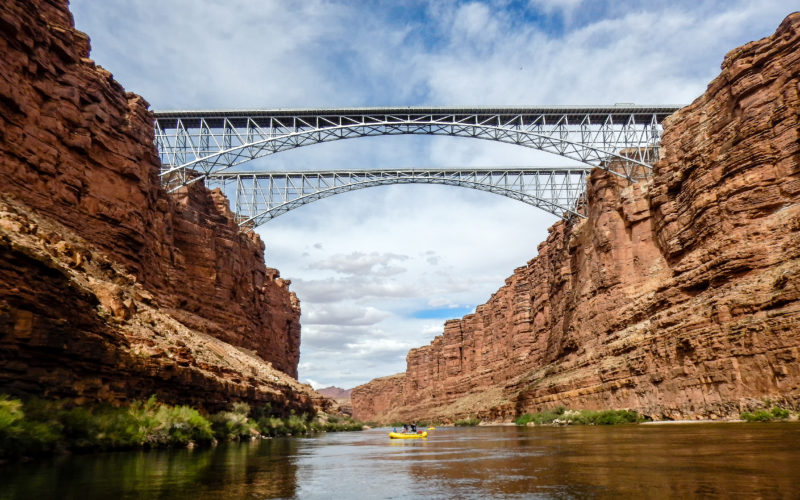
By Isaac and Max Finkelstein
My Dad says that just about everything he has ever learned, he learned from a river (well, and from our mothers).
So when it came time for me to head back to school after a summer guiding rafts on the Ottawa River, it just made sense to follow that same river from our home in Ottawa to Concordia University in Montreal. When my parents came to visit me at my summer job (they actually paddled there from their home in Ottawa), I had a crazy idea.
“You know, Papa, we should paddle back to school.”
“Why not,” my Dad said. “It’s a straight shot down the Ottawa River, with a left turn onto the Lachine Canal.”
“…and if we stop at the Atwater Market, I’m only a few kilometres from my apartment!”
“Perfect!” Dad says, “we’ll bring canoe wheels and make it a door-to-door trip…Hmmm..about 200 km, so we should be able to do it with two nights camping.”
Day 1
And so here we are, a few weeks later, on our way. Out the door of our house in Ottawa, jogging down the street, with our trusty canoe lashed on to a set of wheels. It’s about one kilometre from our house to Westboro Beach (one down, 199 or so to go).
And then we are off. On our way.
Paddling the Ottawa River through the city is a fabulous trip. We slide down the rapids under the Champlain Bridge, slither down the shallows past the rock sculptures at Remic Rapids, snake our way through the rocky islands above the Chaudiere Dam, and soon come to our next obstacle, the Chaudiere Dam. We land above the dam near the Canadian War Museum, put our canoe back on the wheels, and jog down the bike path (getting a few weird looks from passing cyclists) to Richmond Landing, just below the Supreme Court Building in downtown Ottawa. Then back on the water, with no more portages until we reach Carillon Dam and Locks, about 130 km downriver.
We paddle underneath the Parliament Buildings, past Rideau Falls, and soon leave the city behind. The Ottawa River is not a wilderness river, but it is a lively one. Bald eagles and ospreys soar overhead. The Quebec shore is lined with vast beds of cattails and sedges; the islands forested with hackberries and silver maples. We can only imagine what lurks beneath the water.
We camp at a boat launch in the small riverside town of Wendover, where the South Nation River meets the Ottawa.
Day 2
We are off again in the morning mist, the bow of our canoe slicing through calm waters. But soon the wind picks up. We put up a sail, and congratulate ourselves as we fly past the huge log hotel at Montebello, Quebec. Soon the wind and waves convince us to take down our sail, and we sneak along the Ottawa.
There is a large sandy delta where the Rouge River meets the Ottawa. Here, the river is dotted with kite surfers, skimming back and forth, and leaping off the waves like popcorn popping. One kite surfer playfully takes aim at us plodding along in the waves, and leaps high over canoe. He is so high up, we imagine he might be blown all the way to Montreal. But he lands gracefully at the edge of the rushes, whips the board 180 degrees, and begins another run. We are in awe.
We reach the Carillon Dam and locks, windblown and tired, at 6:00 PM. Built in 1963, it raised the water level 19 metres, flooding three sets of rapids and transforming this section of river into a long, and for us, very windy and wavy, lake. We’ve missed the last lockage, and have to portage our canoe around the dam. Below the dam, predators abound – bald eagles patrol the skies, and human predators the waters. Our damp spirits (we were actually very damp from the splashing of waves), rise when we walk into the town of Carillon and see a ‘Casse-Croute’. But sadly for us, it has closed just minutes before we arrive, and we have to survive on cheesy noodles cooked over our camp stove.
Day 3
Morning 3, and we are off for the last push to Montreal, with about 85 km left to go. We have lac des Deux Montagnes in front of us, a very big, windy body of water. Imagine the ecological richness of this lake in pre-settlement days. It is still a biologically rich area, with wild rice beds far out in the lake. Several muskellunge leap from the water, while the now-familiar bald eagles watch from above. A scary place to be a small fish.
The ecological richness, however, is surpassed by the economic richness. Rows of huge mansions with expansive lawns sprout up beside the water, and huge motorboats speed by us. Both grow in size and frequency as we approach the Autoroute 40 bridge. Here the lake narrows, its waters change from Ottawa River brown to St. Lawrence River turquoise. We have to cross the boat channel to reach the locks at St. Anne de Bellevue. Is this how a turtle feels when crossing a highway? A continuous parade of motorboats streams by, raising wakes that you could surf on. We see a gap in the traffic, and as Dad shouts: “Go! Go! Go!”, we go for it.
We are paddling as fast as we can, but a big speedboat has us in its sights, like a muskellunge stalking a perch. Incredulously, we watch as it speeds up and heads straight towards us. At the last moment, it veers away, coming close to colliding with another speedboat travelling from the opposite direction! Perhaps it is true that brain-power is inversely proportional to horsepower, we wonder as we paddle into the safety of the shallow, rocky waters near shore and head towards the lock.
It was at St. Anne de Bellevue that the voyageurs of fur trade days received their final blessings at the church here before heading into the interior on their months-long voyages. There are shallow rapids separating the waters of the Ottawa and St. Lawrence that are now by-passed by the lock and canal. We decide to take the lock, and pay our 90 cents/foot fee. We are packed in with about a dozen big motor boats. The doors close behind us, and then the doors in front open. Everyone (except us) starts their engines, and the whole procession slowly moves out into the canal. There was no drop in water level, no swirling currents in the lock as water is sucked out. What’s going on? And then it dawns on us: We were duped! This year, the water in the St. Lawrence is still so high that there is no drop in level between lac des Deux Montagnes and the St. Lawrence. We could have just paddled right through.
The Last Lap
We are in Montreal, but still have about 40 km left to go. We paddle along the shore of lac St. Louis (actually a widening of the St. Lawrence) and into the Lachine Canal, portage around two sets of locks, and tie up at a dock near a fancy floating restaurant, opposite the Atwater Market. We portage canoe and gear one last time, clumsily manoeuvring the canoe around two 90 degree bends and trudge up the ramp to street level. The restaurant patrons look on with mild curiosity. Back on our trusty wheels, we realize we are starving, and don’t go far before we lock up the canoe outside the Green Spot Diner. We sit down, at last, to a well-deserved meal, before hauling the canoe the last few kilometres to my apartment, just in time for classes tomorrow.

